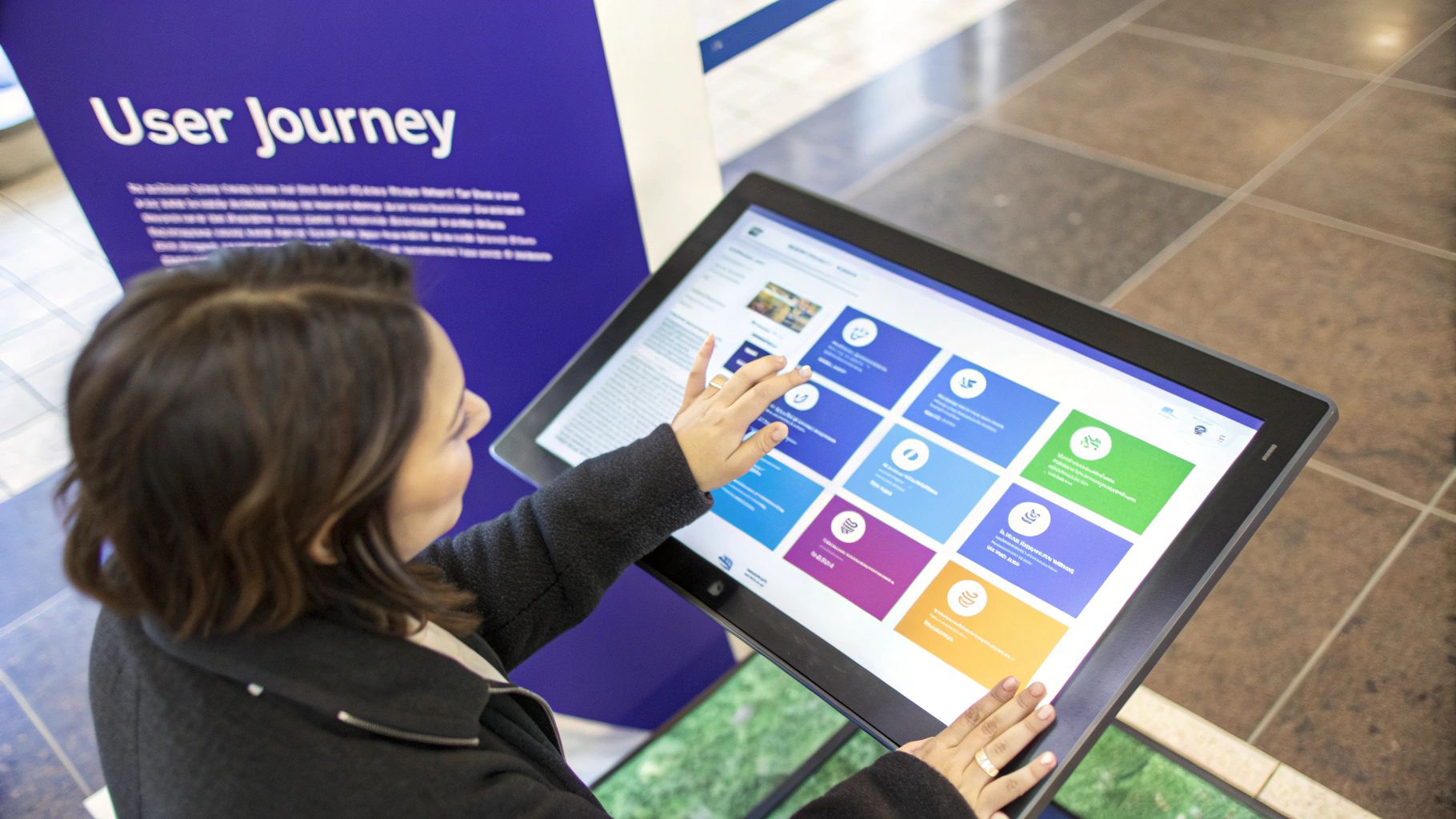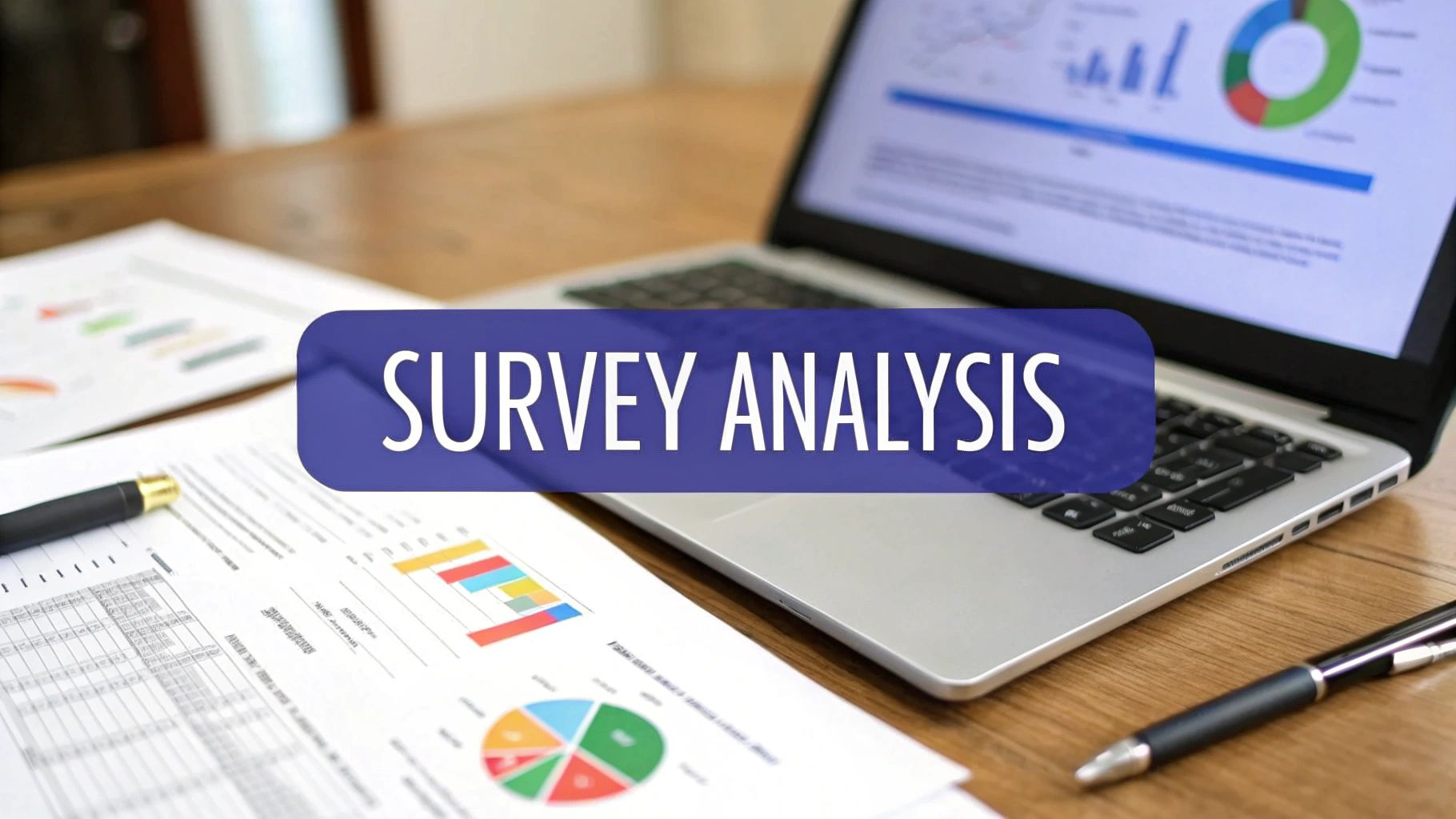Top 7 Qualitative Research Survey Questions for SaaS in 2025
Discover essential qualitative research survey questions to enhance SaaS insights in 2025. Boost your research with proven qualitative research survey questions.

Understanding the 'why' behind user behavior is essential for survival and growth. While quantitative data tells you what users are doing, it often falls short of explaining their motivations, frustrations, and desires. This is where qualitative research shines. By asking the right kinds of open-ended questions, you can move beyond simple metrics and uncover the rich, contextual stories that drive churn, retention, and loyalty.
This article provides a strategic guide for SaaS teams, breaking down 7 essential types of qualitative research survey questions. We'll move beyond generic examples, offering deep analysis, tactical advice, and actionable takeaways to help you craft surveys that deliver truly meaningful insights. To truly unlock deeper user insights, it's beneficial to understand not just qualitative approaches, but also the spectrum of broader research methodologies.
Whether you're refining a feature, mapping a user journey, or trying to understand churn, these question frameworks will equip you to listen more effectively and build a better product. Let's dive into the examples.
1. Open-Ended Exploratory Questions: Casting a Wide Net for Discovery
These are broad, non-directive questions that allow participants to share their thoughts, feelings, and experiences without constraints. They typically begin with 'What,' 'How,' or 'Why' and encourage detailed, narrative responses that reveal underlying motivations, attitudes, and perceptions. For a SaaS business, these are the perfect starting point for understanding a new user segment or exploring initial reactions to a product concept before you've formed any hard hypotheses.

Strategic Analysis
Exploratory questions are the bedrock of qualitative research. Their power lies in their lack of direction; you aren't leading the user toward a specific answer. This approach is invaluable during the early stages of product development, market research, or when diagnosing a vague problem like low feature adoption. The goal is to uncover the "unknown unknowns" - the insights you didn't even know to ask about.
For example, asking, "Describe your biggest challenge related to project management" is far more insightful than, "Is managing deadlines your biggest challenge?" The first version opens the door to hearing about communication breakdowns, software integration issues, or team morale, while the second limits the user to a simple yes or no on a single topic.
Strategic Insight: Use exploratory questions to build a foundational understanding of your user's world. The rich, narrative data you collect can inform future hypotheses, guide feature development, and shape your marketing language to resonate more deeply with your target audience.
Tactical Application
To effectively use these types of qualitative research survey questions, focus on creating a space for storytelling. Your prompt should act as a simple doorway, not a narrow hallway.
- When to Use:
- Early-Stage Discovery: When exploring a new market or product idea.
- Onboarding Feedback: To understand initial user impressions and goals.
- Churn Analysis: When trying to understand the root causes of why users leave.
- Frame with 'What' or 'How': Start your questions with words that demand descriptive answers. For instance, "What were you hoping to achieve when you first signed up?" prompts a story about goals and expectations.
- Focus on Specific Contexts: Instead of a generic "How do you use our product?", try "Walk me through how our platform fits into a typical task for your team." This grounds the response in a real-world scenario.
- Prepare for Messy Data: The responses will be varied and unstructured. Be ready to use thematic analysis to identify recurring patterns, sentiments, and key themes in the answers. This is where the true value is found.
2. Experience-Based Narrative Questions: Unpacking the User's Story
These questions prompt participants to recount specific, real-world events or situations in their own words. Instead of asking for general opinions, you ask for a story. This technique is designed to capture the context, sequence, and emotional arc of an experience, providing incredibly rich qualitative data grounded in actual behavior, not just abstract attitudes. For a SaaS company, this is how you move from "users say they want X" to understanding the real-life scenario that makes X a critical need.

Strategic Analysis
Narrative questions are powerful because they bypass sanitized, logical responses and tap into memory and emotion. People are natural storytellers, and asking them to share an experience often reveals subtle details, pain points, and workarounds they wouldn't think to mention in response to a direct question. This method is a cornerstone of ethnographic and customer experience research.
For instance, asking, "Walk me through the last time you had to prepare a report for your manager," will unearth details about data gathering, tool-switching, collaboration friction, and presentation anxiety. This is far more illuminating than a question like, "Do you find reporting difficult?" The story reveals the why and how behind the user's feelings, providing a detailed map of their journey, complete with obstacles and moments of relief.
Strategic Insight: Use narrative questions to understand the user journey on a micro-level. The stories you collect are not just data; they are user-generated process maps that highlight critical friction points and opportunities for your product to become an indispensable hero in their workflow.
Tactical Application
To effectively use these types of qualitative research survey questions, you need to be a good story prompter. Your goal is to get the user to hit 'play' on a memory.
- When to Use:
- Customer Journey Mapping: To understand a specific process, like onboarding or collaborating on a task.
- Feature Validation: To learn about the real-world problem a proposed feature is meant to solve.
- Usability Testing: To hear the story of how a user navigated a complex workflow.
- Anchor in a Specific Moment: Use prompts like "Tell me about a time when..." or "Walk me through the last time you..." to ground the question in a single, concrete event rather than a general habit.
- Ask for the "Before and After": Prompt for context. Ask, "What was the situation right before you started using our tool for that task?" and "What was the final outcome?" This frames the narrative and reveals the perceived value.
- Listen for Emotions and Workarounds: Pay close attention to emotional language ("it was so frustrating," "a huge relief") and mentions of external tools or hacks. These are bright red flags indicating significant pain points or unmet needs.
3. Value and Belief Exploration Questions: Uncovering the 'Why' Behind the 'What'
These questions go beyond behavior to uncover the core values, beliefs, and principles that shape a participant's worldview and guide their decisions. They help you understand the deeper motivational drivers and moral compass influencing their actions. For a SaaS company, this is critical for aligning your brand mission, product positioning, and marketing messages with the values your ideal customers hold dear.

Strategic Analysis
Value exploration questions provide the deepest layer of customer understanding. While behavioral questions tell you what users do and exploratory questions tell you how they do it, these questions reveal why it matters to them on a fundamental level. This is where you move from building a functional tool to creating a brand that users feel a genuine connection with.
For instance, a project management tool could ask, "What does 'successful collaboration' mean to you and your team?" One user might describe it in terms of efficiency and hitting deadlines (a value of productivity). Another might describe it as a process where everyone feels heard and respected (a value of inclusivity). These different value systems demand different product features and marketing language.
Strategic Insight: Aligning your product with user values creates powerful brand loyalty. When users see their own principles reflected in your software or company mission, they become advocates, not just customers. This data is invaluable for building a compelling brand story and making strategic decisions that resonate emotionally.
Tactical Application
To effectively use these types of qualitative research survey questions, you must create a sense of trust and psychological safety. These questions can be personal, so the framing and context are everything.
- When to Use:
- Brand Strategy: When defining or refining your brand's mission, vision, and voice.
- Market Positioning: To understand how to connect with a target segment on a deeper, more emotional level.
- High-Level Product Vision: When making long-term roadmap decisions that reflect a specific ethos (e.g., prioritizing sustainability, collaboration, or security).
- Use Scenarios to Ground Abstract Ideas: Instead of a vague "What do you value?", ask, "When choosing a new software tool for your team, what principles are most important in your final decision?" This anchors the abstract concept in a concrete, relatable experience.
- Frame with Neutrality and Care: Questions must be non-judgmental. Asking "How important is work-life balance to you when evaluating a new tool?" invites an honest reflection. Avoid leading questions that imply a "correct" value system.
- Connect Values to Behavior: Follow up a value question with a behavioral one. For example, after a user says they value data privacy, you could ask, "Can you describe a time you took action or chose a product based on that principle?" This links their stated belief to a tangible action.
4. Process and Journey Mapping Questions: Charting the User's Path
These questions are designed to deconstruct a user's experience by asking them to narrate a process or workflow step-by-step. They move beyond single actions to capture the entire sequence of events, thoughts, and feelings involved in completing a task. For a SaaS platform, this is critical for understanding how your product integrates into a user's larger workflow, revealing hidden friction points, workarounds, and opportunities for improvement.
Strategic Analysis
Process and journey mapping questions provide a timeline of the user experience. Their strategic value comes from creating a holistic, ground-level view of how users actually interact with your system to achieve a goal, rather than how you assume they do. This method uncovers the messy reality of user behavior, including the external tools they use, the emotional highs and lows they experience, and the clever-but-inefficient workarounds they invent.
For instance, asking "Walk me through the exact steps you take to prepare and send your monthly client report" is incredibly revealing. You might discover they export data from your app, manually clean it in Excel, create charts in a separate BI tool, and finally paste it all into a PowerPoint. This single answer can expose gaps in your reporting features, highlight integration opportunities, and pinpoint the most frustrating parts of their workflow.
Strategic Insight: Use process mapping questions to diagnose inefficiencies and identify high-value integration or feature opportunities. By understanding the entire user journey, including steps that happen outside your app, you can evolve your product from a simple tool into an indispensable part of their workflow.
Tactical Application
To effectively use these types of qualitative research survey questions, you need to prompt users to be detailed storytellers of their own processes. Your goal is to create a chronological map of actions and feelings.
- When to Use:
- Feature Optimization: To understand how a specific feature is used in a real-world context.
- Onboarding Analysis: To map the user's journey from sign-up to their first "aha!" moment.
- Identifying Friction: To pinpoint exactly where and why users get stuck or frustrated.
- Start Broad, Then Probe: Begin with a broad request like, "Describe how you accomplish [Goal X]." Follow up with probes for each step: "What were you feeling at that point?" or "What tool did you use for that specific action?"
- Focus on Transitions: Pay close attention to the moments when users switch between tools or tasks. These are often the points of greatest friction and where the most valuable insights lie.
- Encourage Honesty about Workarounds: Explicitly ask, "Do you have any 'tricks' or workarounds you use to get this done?" This gives users permission to share the unofficial, often ingenious, ways they make a process work for them. For a deeper dive, a customer journey mapping template can provide a structured framework for this analysis.
5. Comparison and Preference Questions: Uncovering the 'Why' Behind Choices
These questions move beyond isolated experiences to ask participants to directly compare products, features, or concepts and articulate the rationale behind their preferences. By pitting options against each other, you force a deeper level of cognitive processing, revealing the specific criteria, values, and trade-offs that drive user decisions. For a SaaS team, this is crucial for understanding your competitive standing and pinpointing your unique value proposition in the user's mind.
Strategic Analysis
Comparison questions are your direct line into the user’s decision-making framework. They are less about evaluating your product in a vacuum and more about understanding its position within the user's broader ecosystem of tools and solutions. This method is exceptionally powerful for competitive intelligence, feature prioritization, and refining your market positioning.
For instance, asking, "Compare your experience using our reporting feature to the one you used in your previous software," forces a direct comparison. The user might reveal that while your competitor's tool had more metrics, yours is significantly faster and more intuitive, highlighting that usability is their key preference. This is a far more strategic insight than just asking if they like your reporting feature.
Strategic Insight: Use comparison questions to map out your competitive landscape from the user's perspective. Understanding not just what they choose but why they choose it allows you to double down on your strengths and address your perceived weaknesses with surgical precision.
Tactical Application
To effectively leverage these qualitative research survey questions, you need to frame comparisons that are meaningful and relevant to the participant's actual choices. Avoid hypothetical or abstract comparisons whenever possible. You can explore more about framing these and other types of survey questions on surva.ai.
- When to Use:
- Competitive Analysis: When you need to know how you stack up against specific competitors.
- Feature Prioritization: To understand which of several potential features is most valuable.
- Post-Onboarding: To gauge how your initial experience compares to alternatives they may have considered.
- Ask for the 'Why': The comparison itself is only half the story. Always follow up with a prompt like, "What factors led you to that preference?" or "Could you explain what makes that option better for you?"
- Be Specific and Grounded: Instead of a vague "Compare us to competitors," ask, "Thinking about [Competitor X], what are the one or two things our platform does better, and what are one or two things they do better?" This elicits specific, actionable feedback.
- Allow for Nuance: Recognize that preference isn't always absolute. Include options like 'It depends on the situation' and ask them to elaborate on those situations. This can reveal different use cases and contexts you hadn't considered.
6. Hypothetical Scenario Questions: Gauging Future Behavior
These questions present participants with imaginary but plausible situations, asking how they would respond, feel, or act. They are designed to explore potential reactions to new concepts, test ideas before implementation, and understand behavioral intentions in controlled scenarios. For a SaaS company considering a major feature overhaul or a new pricing tier, these questions are a low-risk way to gauge user sentiment and anticipate market reception.
Strategic Analysis
Hypothetical scenario questions are a powerful tool for peering into the future. Their strength lies in detaching users from their current reality and placing them into a specific, controlled context where they can freely consider possibilities. This is crucial when you need to understand how users might react to a change that doesn't exist yet, moving beyond current usage patterns to explore potential future actions. The goal is to understand the why behind a potential decision, not just the decision itself.
For example, asking "Imagine we introduced an AI-powered assistant that automatically organized your projects. How would that change your daily workflow?" is more revealing than "Would you like an AI assistant?" The first question prompts users to visualize the impact on their process, uncovering potential benefits, adoption hurdles, or unforeseen use cases. It helps you understand how a feature fits into their world before a single line of code is written.
Strategic Insight: Use hypothetical questions to de-risk future product decisions and strategic shifts. The qualitative data you gather can validate a concept's appeal, highlight potential objections, and provide a roadmap for a successful launch by aligning the feature with user expectations and desired outcomes.
Tactical Application
To effectively deploy these types of qualitative research survey questions, you need to build scenarios that are both creative and grounded in reality. The key is to make the hypothetical feel plausible enough for users to engage with it seriously.
- When to Use:
- New Feature Validation: Before investing development resources in a major new feature or product.
- Pricing Model Testing: To understand user reactions to different pricing structures or tiers.
- Major UI/UX Changes: When planning a significant redesign of your platform's interface.
- Provide Rich Context: Don't just ask about a feature; describe the scenario. Instead of "What if we added integrations?", try "Imagine you could seamlessly connect our tool with your CRM and email client, eliminating two hours of manual data entry per week. How would this impact your team's efficiency?"
- Focus on the "Why": Always include a follow-up question to probe the reasoning behind their hypothetical action. Questions like "What would be your biggest concern in that situation?" or "What would be the most exciting part of that for you?" get to the core motivations.
- Keep it Grounded: While hypothetical, the scenario must be relatable to the user's actual job or life. An unrealistic scenario will yield unrealistic, unhelpful answers. Connect the hypothetical to a real-world pain point you've already identified.
7. Emotional Response and Feeling Questions: Probing the 'Heart' of the User Experience
These questions are designed to move beyond logic and functionality to tap directly into the user's affective state. They probe for emotional reactions, feelings, and moods associated with a product, brand, or specific interaction. For a SaaS company, understanding the emotional journey, from the frustration of a bug to the delight of a seamless workflow, is crucial for building user loyalty and designing experiences that resonate on a deeper level.
Strategic Analysis
Logic dictates user actions, but emotion drives user loyalty. Emotional response questions uncover the powerful, often subconscious, drivers behind user behavior. A feature might be technically proficient, but if it makes users feel anxious or incompetent, it will fail. Conversely, an interface that evokes feelings of calm, confidence, or even delight can create a powerful, lasting bond with your brand.
For example, asking "Describe your feelings when a software update changes the user interface" gets to the heart of change aversion. You might uncover feelings of anxiety about relearning workflows, frustration over lost productivity, or excitement about new capabilities. This is far more valuable than simply asking if they "like" the new design, which often elicits a superficial, logical response.
Strategic Insight: Use emotional response questions to map the affective journey of your users. The data you gather reveals critical moments of friction and delight, highlighting opportunities to reduce user stress, increase engagement, and build a product that users don't just use, but genuinely enjoy.
Tactical Application
To effectively use these types of qualitative research survey questions, you must create a safe space where participants feel comfortable sharing their feelings without judgment. The goal is to understand their emotional truth, not to steer them toward a "correct" feeling.
- When to Use:
- User Experience (UX) Research: To evaluate the emotional impact of a new design or feature.
- Brand Perception Studies: To understand how your brand makes customers feel.
- Customer Support Interaction Analysis: To gauge the emotional fallout from a support ticket or a problem resolution.
- Use Evocative Prompts: Instead of asking "How do you feel?", which can be too broad, try framing the question around a specific event. For example, "Walk me through how you felt the last time you successfully completed a major project using our tool."
- Ask About Highs and Lows: Prompt users to describe both positive and negative emotional peaks. Ask, "Describe a time the product made you feel powerful or efficient," and follow up with, "Now, describe a time it made you feel frustrated or stuck."
- Listen for Emotional Language: Pay close attention to the specific words users choose, like "annoyed," "relieved," "overwhelmed," or "empowered." These keywords are powerful data points that can be themed and analyzed to pinpoint exact areas for improvement in the user experience.
7 Types of Qualitative Survey Questions Compared
Question TypeImplementation Complexity 🔄Resource Requirements ⚡Expected Outcomes 📊Ideal Use Cases 💡Key Advantages ⭐Open-Ended Exploratory QuestionsMedium - requires skilled analysisModerate - time for coding and analysisRich, detailed insights; uncovers unexpected motivationsExploratory research, depth understandingGenerates comprehensive data; reveals new directionsExperience-Based Narrative QuestionsMedium-High - detailed storytelling neededHigh - time-intensive for collection & analysisAuthentic accounts; context and emotional depthUnderstanding behaviors, decision-making contextCaptures real experiences; easier for participantsValue and Belief Exploration QuestionsHigh - abstract and sensitive topicsModerate-High - careful facilitation neededDeep motivational insights; reveals cultural value patternsBrand positioning, motivational driver analysisPredicts behaviors; uncovers cultural influencesProcess and Journey Mapping QuestionsHigh - complex step-by-step elicitationHigh - detailed data and participant memoryHolistic view of processes; identifies pain pointsUX research, service design, process optimizationActionable insights; maps full experienceComparison and Preference QuestionsMedium - structured but nuancedModerate - requires careful designClear understanding of decision criteria and trade-offsFeature prioritization, competitive analysisGenerates actionable comparative dataHypothetical Scenario QuestionsMedium - scenario design criticalModerate - scenario testingInsights on potential behaviors; tests ideas pre-implementationInnovation research, behavioral intention testingExplores future behaviors; tests sensitive topicsEmotional Response and Feeling QuestionsMedium - subjective and sensitiveModerate - needs safe environmentEmotional drivers and triggers of behaviorEmotional design, brand positioning, user satisfactionReveals authentic emotions; predicts loyalty
From Questions to Growth: Putting Your Insights into Action
Asking powerful qualitative research survey questions is only the first, critical step. The real, transformative growth for your SaaS business happens when you systematically turn those rich, narrative answers into an actionable product strategy and a deeper connection with your users. The journey from question to insight is where market leaders are made.
Throughout this guide, we've dissected seven distinct categories of questions, each designed to unlock a different layer of the user psyche. From open-ended exploratory probes to detailed process-mapping inquiries, this toolkit gives you a comprehensive framework for understanding your customer's world. You now have the templates to move beyond simple satisfaction scores and uncover the "why" behind every user action.
Key Takeaways for Your SaaS Team
Mastering the art of the qualitative question is a superpower. Here are the most important principles to carry forward:
- Context is Everything: The most effective questions are tied directly to a specific user action or journey stage, such as onboarding, feature discovery, or cancellation.
- Go Beyond "What" to "Why": Don't just ask what users did. Use narrative, emotional, and value-based questions to understand their motivations, frustrations, and the deeper goals they are trying to achieve.
- Actionability is the Goal: Every question you ask should be designed to yield an answer you can act on. If you can't imagine a way the responses could influence your product roadmap, marketing copy, or customer success strategy, refine the question.
Turning Qualitative Data into Strategic Assets
Once you've collected this wealth of qualitative data through your well-crafted questions, the next critical challenge is making sense of it all. Raw, unstructured text can be overwhelming, but modern tools can help you find the signal in the noise. For SaaS teams looking to move quickly, finding platforms that help you efficiently categorize and classify your survey responses can significantly streamline this analysis process, transforming raw text into tagged, themed, and actionable insights.
By integrating these frameworks into your feedback loops, you create a continuous stream of deep user understanding. This isn't a one-time project; it's a fundamental shift in how you operate. When the authentic stories and nuanced needs of your users are at the heart of every sprint planning meeting and marketing campaign, you stop just building features. You start building indispensable solutions that customers advocate for, stick with, and can't imagine living without.
Ready to stop guessing what your users want and start knowing? Surva.ai is the AI-powered survey platform built to help you ask better questions and instantly analyze the answers. Move from raw feedback to actionable insights in minutes, not weeks, by letting our AI categorize, tag, and summarize your qualitative data automatically. Get started with Surva.ai today and build the product your customers have been trying to ask for.


